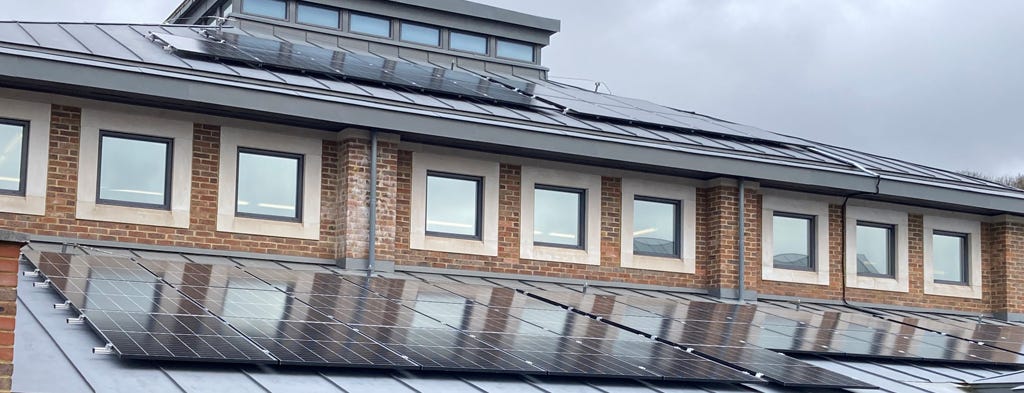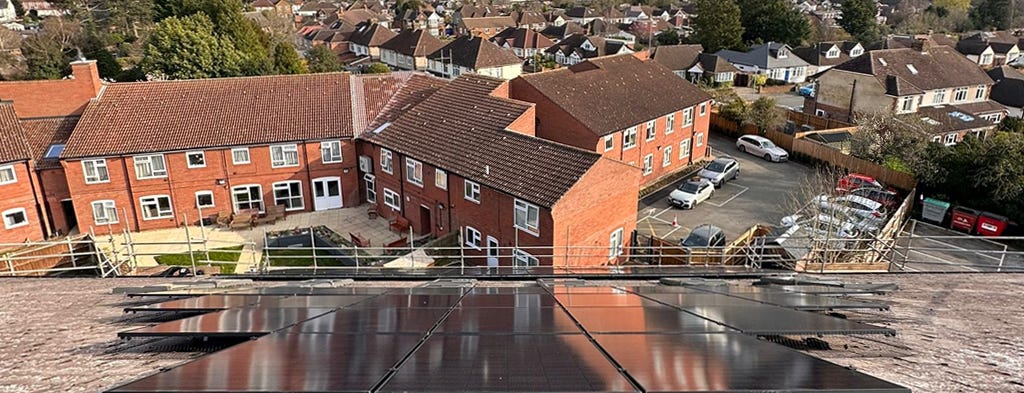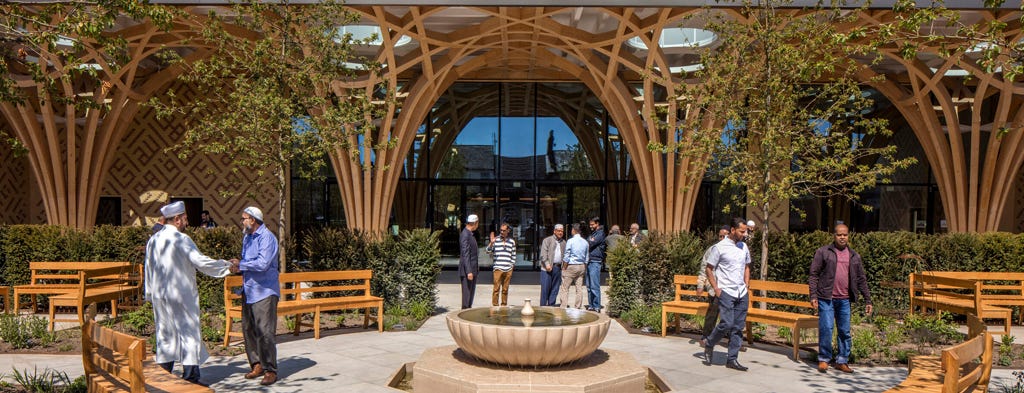Spring is on its way, and there’s green action everywhere. For this newsletter, I spoke to Active Luton about their extensive decarbonisation plans, so we’ve got climate news from mosques and churches, schools and pools.
Solar for High Town Community Centre
New solar array at Stopsley Baptist Church
Stuff for teachers and schools
Learning visit to Cambridge eco-mosque
Solar for High Town Community Centre
Active Luton share the news about their new solar installation:
As part of our ongoing commitment to the Luton 2040 vision and our Environmental and Sustainability strategy, the Board of Active Luton recently funded a project to install solar panels at Hightown Community Sports & Arts Centre.
We are delighted to share that the project is now complete.
In addition to reducing our carbon footprint and the amount of fossil fuels used to power the centre, the solar panels will also reduce the centre’s energy bills.
Did you know Hightown welcomes approximately 6,500 users per month? That’s a lot of energy required to keep lights on, rooms warm and coffees made.
The project itself comprised the installation of 118 panels and it is estimated that we will generate 46 Megawatts of power per year, and we will save over 10 tonnes of CO2 from going into the atmosphere - significantly improving the facility’s environmental footprint.
In addition to the environmental saving, we are anticipating to save approximately £11,000 per year in energy costs. WOW!
In partnership with Luton Borough Council we are now looking at solar PV opportunities at Inspire: Luton Sports Village through a successful funding application with Sport England that we hope will go live later in the year.
Solar PV at Stopsley Baptist Church
Another new solar array in the town can be found on the roof of Stopsley Baptist Church (SBC), which generated its first solar power last week.
For a budget of around £40,000, funded through a legacy, the church was able to install 67 panels and a battery system. This will provide just over half of the building’s annual electricity needs.
With energy prices high at the moment, the system is expected to pay for itself in just three years. From then on, the church can look forward to many years of free energy. The total savings, over the lifetime of the panels, is projected to be over £300,000.
This is a useful case study in the many benefits of solar power, and why we champion it as a climate solution at Zero Carbon Luton. As well as reducing carbon, SBC’s financial savings from the solar array stay in Luton.
Energy bills represent income leaving the town, and heading for the pockets of energy companies and their shareholders. Energy generated locally keeps that money circulating in the local economy.
As an added benefit to the local economy, SBC used a Luton-based contractor, SSU Renewables. “Having both grown up in Stopsley, we are very grateful to have the opportunity to work on this important project in the heart of our community,” said Aaron Hensley & Daniel Williamson, SSU’s directors. “Once the green light was given on the design and planning application, working closely with the church, we got straight to work on the installation a few days later.”
SBC’s Operations Director, Chris Young, explained that there were some delays getting sign-off on the scheme. An architect needed to assess the plan, and it had to be checked for glint that might affect pilots flying in to the airport.
The solar array is the latest step in SBC’s journey to become an eco-church, winning bronze and then silver in the last few years. It is one of several churches signed up to the eco-church programme.
Stuff for teachers and schools
We could do a whole separate newsletter about climate action in Luton schools - and perhaps one day we will. For now, a handful of things for teachers.
Everyone tells us funding and time are the biggest obstacles to climate action in schools. We can’t help with more hours in the day, but here’s a list of funding sources for environmental projects from the CATCh programme.
The first carbon calculator for schools launched recently. It’s called Count Your Carbon, it’s been designed by Keep Britain Tidy, and it’s free to use. Let us know how you get on if you’d like to be in a future newsletter.
Also have a look at Climate Action Countdown, which invites schools to take part in climate related activities in June. And don’t miss Plant Your Pants, a campaign from the Country Trust to get children engaged in soil science.
A visit to Cambridge eco-mosque
Luton doesn’t have an eco mosque - yet - but a group recently visited the pioneering Cambridge Central Mosque to learn more. Architect Eleanor Downs joined faith community members and councillors on the visit, and shares her experience:
Organised by Community Development and Climate Action Officers, a group of Luton Council staff visited the Cambridge Central Mosque for the afternoon. It was a bright crisp January day which showed the mosque and the gardens in a lovely tranquil light. I travelled by train and, having only visited Cambridge on a couple of occasions prior, enjoyed experiencing the transition from the town centre to the residential neighbourhood of Mill Road where the mosque is located. The mosque was designed by Marks Barfield Architects who were selected following a competition. Our tour guide was a practicing member of the community, involved in the process throughout.
I am an architect based in the planning department, so I was most interested in understanding the design process of the mosque, planning and urban design implications, the spatial quality and detailing. On approach, the building integrates well into its surroundings with a sympathetic scale responding to the two storey terraced housing context and sensitive brick specification. Islamic patterning, signage, and the dome all convey the function of the building externally.
We learned that the gardens in front are based on Islamic garden design using native plants. It was fascinating to hear about the 10yr+ process of developing the concept for the project, obtaining the site, growing support and fundraising to deliver such an ambitious scheme. Highly regarded designers and scholars were involved through links with the university and a network of international funders. Through community gardening, being used as a Covid vaccine centre and the openness to tours such as ours, the worshipping community seek to invite the wider city to benefit as well.
The space inside is calm, airy and light with distinctive tree-like, latticed timber columns, patterned marble floor and screens, coloured glass panels and rooflights, and cool green carpet. The plan gently shifts so that the main worshipping space faces Mecca with ancillary café, workspace, ablutions area and exhibition room as well. The generosity of these spaces allows the community to test out new uses envisaged to evolve over time. Afternoon prayers were in progress, and some of our group took the opportunity to pray as well.
As a non-Muslim, it was a privilege to witness the life of the building with this sense of openness and welcome. The sustainable design credentials are impressive with renewable and low energy sources, rainwater harvesting and high thermal performance building envelope.
Overall it was an inspiring and informative visit that showed an example of how a new part of the city can be formed to celebrate culture and community life that is harmonious with the urban fabric and an exemplar of architecture, decorative arts and sustainable design.
In other news…
Great to see Luton Town name-checked by the climate charity Possible as one of a dozen football clubs it considers leaders on sustainable travel. In Luton’s case, it’s thanks to its work encouraging players and supporters to use coach travel.
There’s a new petition against airport expansion on Change.org, for those who would like to sign such a thing. A petition in favour of airport expansion, and heavily promoted by Luton Rising, has recently gathered over 6,400 signatures.
How many edible plants could you find in a local park? Find out with this foraging walk around People’s Park on April 20th. Hosted by Edible High Town, it sees another visit from Jane Simmons (aka the Hitchin Forager) and I can say from experience that previous walks have been excellent.
Over on the Zero Carbon Luton website we’ve had articles up recently on the Playing Out campaign, and Father Luke Larner shared his plans for a new community garden and wellbeing hub at St Andrews, Biscot.
I was recently asked where the electric car charge points are in Luton. All over the place, is the short answer. Here’s the longer one.
What’s even better than electric cars? No cars! So we welcome news of a planned Park & Ride scheme on the Butterfield Business Park - more details next time.




